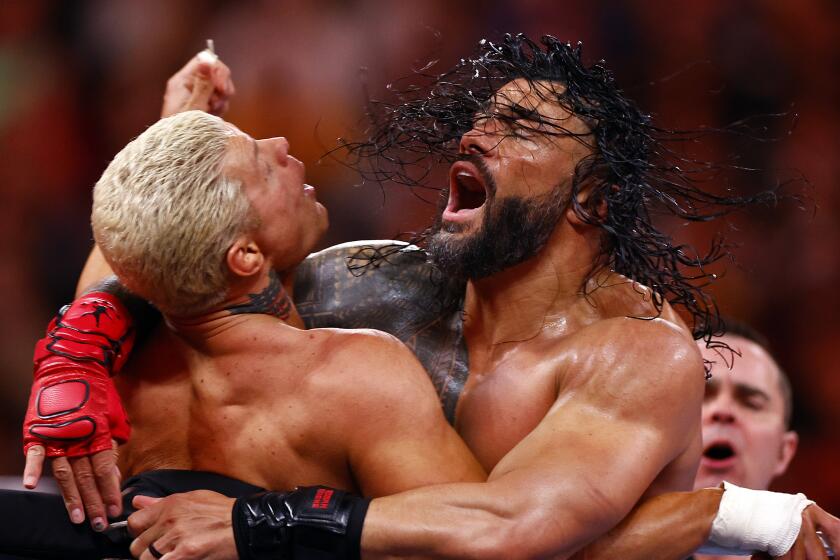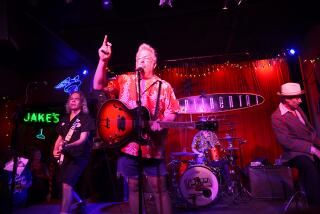Wrestling’s ‘Superstar’ Billy Graham, the template for Hulk Hogan, dies at 79

“I lift barbell plates. I eat T-bone steaks. I’m sweeter than a German chocolate cake. How much more of me can you take?“
When you discuss the hyperbolized figures in pro wrestling history, “Superstar” Billy Graham has to be in the conversation. He was supposed to be a reviled rulebreaker, but after hearing him talk, fans never truly reviled him. At the height of his popularity in the 1970s, Graham sold out Madison Square Garden, the original mecca of pro wrestling, 19 times.
If you are a current pro wrestling fan and never heard of Graham, well, you actually have and just aren’t aware of it. Hulk Hogan, probably the biggest wrestling star of all time, copied a lot of his persona from Graham. The blond goatee. Walking to the ring wrapped in a feather boa. The emphasis on physique. Using the word “brother” liberally in his interviews. If you closed your eyes and listened to prime Graham and prime Hogan, you could barely tell them apart.
“What you gonna do when the Superstar comes down on you?“ —Superstar Billy Graham
“Whatcha gonna do when Hulkamania runs wild on you?”—Hulk Hogan
Graham’s influence can be seen in the greatest of all time — Hogan, Ric Flair, Dusty Rhodes and Jesse Ventura — as well as countless others who never reached superstar level.
Roman Reigns retained his title, Edge and Brock Lesnar emerged victorious and Snoop Dogg improvised when Shane McMahon tore his quad. Here’s a recap of every WrestleMania 39 match at SoFi Stadium.
“Billy was the most influential wrestler of the 1970s,” wrestling journalist and historian Dave Meltzer, author of the Wrestling Observer Newsletter, said. “Obviously, he was the prototype of the Hulk Hogan character, the Jesse Ventura character, but so many others like Dusty Rhodes copied his interview style and colorful dress, and they were the guys who carried the business. Even Chael Sonnen in MMA would directly copy his interviews.”
Graham died Wednesday at age 79, WWE said.
He gained his greatest fame with the then-World Wide Wrestling Federation (WWWF), now known as WWE. Graham, who wrestled for the promotion briefly in 1975, returned in April 1977 and defeated heavyweight champion Bruno Sammartino. He traveled around the world as champion, wrestling such notables as Jack Brisco, Pedro Morales, Rhodes and Mil Mascaras.
“He was a prototype of what Vince McMahon saw as a top wrestling attraction going forward,” Meltzer said. “Billy was neither the first wrestler to use steroids nor the biggest abuser of them, but he was as associated with them as [much as] almost anyone, and later became a very vocal speaker against their use, and sometimes that wavered as he went through different periods of life.”
Graham talked openly about steroid use among wrestling’s biggest stars in a story published by The Times in 1992, catapulting it into the mainstream media for the first time.
“It was sad for a figure, one who made so many people become fans in the first place, to see his life after wrestling, with his health problems, financial problems and mood swings,” Meltzer said. “So many people owe so much of their success to him.”
Graham held the title until February 1978, losing to Bob Backlund. Graham was a heel, but fans reacted positively to him, so much so that Graham asked WWWF owner Vincent J. McMahon, who preceeded his son Vince, to make him a good guy. McMahon, looking at Graham in his tie-dye outfits, feathered boas and goatee, refused, unable to see him as anything other than a bad guy.
Disappointed, Graham left the WWWF and wrestled for other organizations, such as the AWA and NWA, before returning to the then- WWF in 1982. He wrestled for the promotion until 1983 and returned again in 1986. However, by that time, his hips and knees were shot. WWF had a wrestler attack him at ringside to explain his absence, and even showed graphic images of his hip replacement surgery on TV, in hopes he could come back as an inspirational babyface, or good guy. His body was a mess by this time, however, which Graham later blamed on steroids. His wrestling career was over, but it continues to live on thanks to his countless imitators.
But perhaps, even in death, we should let Eldridge Wayne Coleman, born June 7, 1943, but forever known as Superstar Billy Graham, have the last word.
“I am the women’s pet, the men’s regret. What you see is what you get. And what you don’t see is better yet.“
More to Read
Get our high school sports newsletter
Prep Rally is devoted to the SoCal high school sports experience, bringing you scores, stories and a behind-the-scenes look at what makes prep sports so popular.
You may occasionally receive promotional content from the Los Angeles Times.








